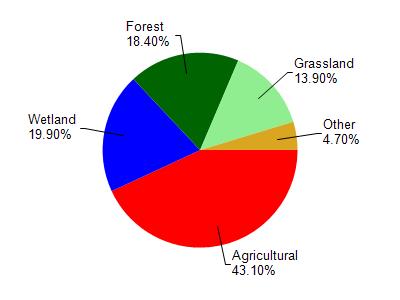Columbia
Yes
No
No
Fish and Aquatic Life
Overview
Jennings Creek is a tributary to Duck Creek. The stream supports a Class II trout fishery. Although the creek is fairly well protected by wetlands, there are still in-stream habitat and water quality issues. Straightening of the stream has resulted in poor in-stream habitat in some locations. In addition, a campground diverts a portion of the stream flow to form a lake. The lake acts to warm the water and once the water is discharged back to the stream, it has an increased temperature and can cause water quality and habitat problems.
Date 2002
Author Cynthia Koperski
Historical Description
Jennings Creek T12N, R11E, Section 20,Surface Acres = 13.24, Miles = 9.1, Gradient = 13.18 feet per mile.
A small spring-fed stream tributary to the Middle Branch, Duck Creek.
The stream has good water quality but has unfortunately been bracketed by private
fish hatchery development. The Conservation Department owns 410 acres with
3.0 miles of stream managed as public hunting and fishing grounds. Brook trout
are common and there is a long history of stocking of this species. Nearly all
lands adjoining state property are posted against trespass at present. Over
212 acres of wetland adjoin the stream. Waterfowl provide fair shooting and
muskrats are present in significant numbers.
From: Poff, Ronald J. and C.W. Threinen, 1965. Surface Water Resources of Columbia County:
Lake and Stream Classification Project. Wisconsin Conservation Department, Madison, WI.
Date 1965
Author Surface Water Inventory Of Wisconsin
General Condition
Jennings Creek was assessed during the 2018 listing cycle; new biological (macroinvertebrate Index of Biotic Integrity (IBI) scores) sample data were clearly below the 2018 WisCALM listing thresholds for the Fish and Aquatic Life use. This water was meeting this designated use and was not considered impaired.
Date 2017
Author Ashley Beranek
Condition
Wisconsin has over 84,000 miles of streams, 15,000 lakes and milllions of acres of wetlands. Assessing the condition of this vast amount of water is challenging. The state's water monitoring program uses a media-based, cross-program approach to analyze water condition. An updated monitoring strategy (2015-2020) is now available. Compliance with Clean Water Act fishable, swimmable standards are located in the Executive Summary of Water Condition in 2018. See also the 'monitoring and projects' tab.
Reports
Management Goals
Wisconsin's Water Quality Standards provide qualitative and quantitative goals for waters that are protective of Fishable, Swimmable conditions [Learn more]. Waters that do not meet water quality standards are considered impaired and restoration actions are planned and carried out until the water is once again fishable and swimmable
Management goals can include creation or implementation of a Total Maximum Daily Load analysis, a Nine Key Element Plan, or other restoration work, education and outreach and more. If specific recommendations exist for this water, they will be displayed below online.
Monitoring
Monitoring the condition of a river, stream, or lake includes gathering physical, chemical, biological, and habitat data. Comprehensive studies often gather all these parameters in great detail, while lighter assessment events will involve sampling physical, chemical and biological data such as macroinvertebrates. Aquatic macroinvertebrates and fish communities integrate watershed or catchment condition, providing great insight into overall ecosystem health. Chemical and habitat parameters tell researchers more about human induced problems including contaminated runoff, point source dischargers, or habitat issues that foster or limit the potential of aquatic communities to thrive in a given area. Wisconsin's Water Monitoring Strategy was recenty updated.
Grants and Management Projects
Monitoring Projects
| WBIC | Official Waterbody Name | Station ID | Station Name | Earliest Fieldwork Date | Latest Fieldwork Date | View Station | View Data |
|---|
| 1270200 | Jennings Creek | 10053301 | Columbia 6 Spring, Jennings Creek Spring | 4/16/2015 | 7/31/2019 | Map | Data |
| 1270200 | Jennings Creek | 10029038 | Jennings Creek 30m Upstream from Ludwig Rd | 1/1/2015 | 1/1/2015 | Map | Data |
| 1270200 | Jennings Creek | 10009949 | Jennings Creek - Jennings Creek 160 Meters Downstream From Ludwig Road | 5/30/2014 | 1/1/2015 | Map | Data |
| 1270200 | Jennings Creek | 10055202 | Jennings Creek DNR Land Timber Sale Crossing | | | Map | Data |
| 1270200 | Jennings Creek | 10011016 | Jennings Creek - Middle Section Off Gunderson Lane | | | Map | Data |
| 1270200 | Jennings Creek | 10016477 | Jennings Creek - 15 M Downstream Of Old Hwy B | 11/6/2003 | 1/1/2015 | Map | Data |
|

Watershed Characteristics
Jennings Creek is located in the Duck Creek and Rocky Run watershed which is 140.89 mi². Land use in the watershed is primarily agricultural (43.10%), wetland (19.90%) and a mix of forest (18.40%) and other uses (18.60%). This watershed has 232.25 stream miles, 1,895.92 lake acres and 16,023.66 wetland acres.
Nonpoint Source Characteristics
This watershed is ranked Medium for runoff impacts on streams, Low for runoff impacts on lakes and High for runoff impacts on groundwater and therefore has an overall rank of High. This value can be used in ranking the watershed or individual waterbodies for grant funding under state and county programs.However, all waters are affected by diffuse pollutant sources regardless of initial water quality. Applications for specific runoff projects under state or county grant programs may be pursued. For more information, go to surface water program grants.